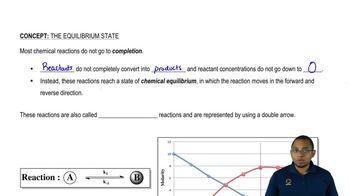Here are the essential concepts you must grasp in order to answer the question correctly.
Chemical Equilibrium
Chemical equilibrium occurs when the rates of the forward and reverse reactions are equal, resulting in constant concentrations of reactants and products. At this point, the system is in a state of balance, and the concentrations of all species remain unchanged over time. Understanding this concept is crucial for analyzing how reactions shift in response to changes in conditions, such as concentration, temperature, or pressure.
Recommended video:
Chemical Equilibrium Concept 1
Equilibrium Constant (K)
The equilibrium constant (K) quantifies the ratio of the concentrations of products to reactants at equilibrium for a given reaction at a specific temperature. A large K value (greater than 1) indicates that products are favored at equilibrium, while a small K value (less than 1) suggests that reactants are favored. In this case, K = 24.2 implies that the formation of products is favored in the reaction provided.
Recommended video:
The Equilibrium Constant Concept 1
Le Chatelier's Principle
Le Chatelier's Principle states that if a dynamic equilibrium is disturbed by changing the conditions, the system will adjust to counteract the change and restore a new equilibrium. This principle helps predict how changes in concentration, temperature, or pressure will affect the position of equilibrium, allowing for a better understanding of how the reaction will respond to various external influences.
Recommended video:
The following is an endothermic reaction where Kc = 6.73 x 103.For each of the choices below predict in which direction the reaction will proceed
 Verified step by step guidance
Verified step by step guidance


